July 18 - 24, 2021: Issue 502
Pittwater's Ground Nesting Birds
A little while ago a stroll with some youngsters brought us in contact with some Buff Banded Rails as these gorgeous little birds scurried along the ground beside Careel Creek and Careel Bay wetlands, then ducked under close by ferns.
This brought a ‘flurry’ of questions of course; What bird is that? Don’t all birds fly? and, Where is their nest?
Although Pittwater is rich with birds that do soar overhead, and nest in trees or even atop cliffs if they’re a sea eagle, there are several species that have always nested on the ground, in the grass, on the sand, and on cute little floating platforms of nests that sit adjacent to creek banks.
For those youngsters who wanted to know more, and for older residents who may not be aware of why Birders will ask you to ‘look out where you’re treading’, here are just some of those you will find year round, or returning to breed each Summer, around here. If you'd like a complete list, please visit this page for beach and shorebirds - it's those sighted by Birders at Long Reef, along with the time of year you will see them if they're returning migraters: https://ebird.org/hotspot/L928252/media
For bush and wetland birds, Warriewood's wetlands provides a list (watch out for those cute Painted Button-quails, Dusky Moorhens and Masked Lapwings): https://ebird.org/hotspot/L2198738
eBird Australia Overview
The precursor to eBird Australia was Eremaea Birds, developed by Richard and Margaret Alcorn - I can remember accessing that one almost two decades ago to record where and when our local birds ware present - especially those who come here to make more birds!
Those that live here year round make more baby birds year round, with some starting around now - mid winter.
Many of those that come for an annual visit start arriving in August and by February and into late Autumn they can be 'thick on the ground' - pun intended.
Launched in March 2003, Eremaea Birds rapidly became the web site of choice for Australian birders for recording and maintaining their bird sightings in Australia and overseas. Eremaea Birds merged with the Cornell Lab of Ornithology eBird project in February 2014 to become Eremaea eBird, the Australia portal for eBird. The portal was later renamed to eBird Australia.
A real-time, online checklist program, eBird has revolutionized the way that the birding community reports and accesses information about birds. Launched in 2002 by the Cornell Lab of Ornithology and National Audubon Society, eBird provides rich data sources for basic information on bird abundance and distribution at a variety of spatial and temporal scales.
eBird’s goal is to maximise the utility and accessibility of the vast numbers of bird observations made each year by recreational and professional bird watchers. It is amassing one of the largest and fastest growing biodiversity data resources in existence.
The observations of each participant join those of others in an international network of eBird users. eBird then shares these observations with a global community of educators, land managers, ornithologists, and conservation biologists. In time these data have become the foundation for a better understanding of bird distribution across the western hemisphere and beyond.
These lists will give you an overview of what can be seen living right along all our bush tracks and beaches, and hopefully some of the photos we share below will help you identify them when you're next doing some exercise while looking for Northern Beaches Secret Rocks!
Council has put up some signage in some of these places to let you know what birds come to these shores, as well as those who live here all year round - so keep a look out for those too, there's some great information and images as well.
I hope you enjoy your strolls youngsters - just watch where you're treading!
A. J. Guesdon
July 2021
Some Of Those On This List
Among the grasses and fields:
Buff Banded Rails
Their nests are usually situated in dense grassy or reedy vegetation close to water, with a clutch size of 3-4.
The Buff-banded Rail (Gallirallus philippensis) is a distinctively coloured, highly dispersive, medium-sized rail of the family Rallidae. This species comprises several subspecies found throughout much of Australasia and the south-west Pacific region, including the Philippines(where it is known as Tikling), New Guinea, Australia, New Zealand (where it is known as the Banded Rail or Moho-pereru in Māori)
They feed on snails, crabs, spiders, beetles and worms, feeding at dawn, dusk and after high tide. They can run at great speed but seldom take to flight.
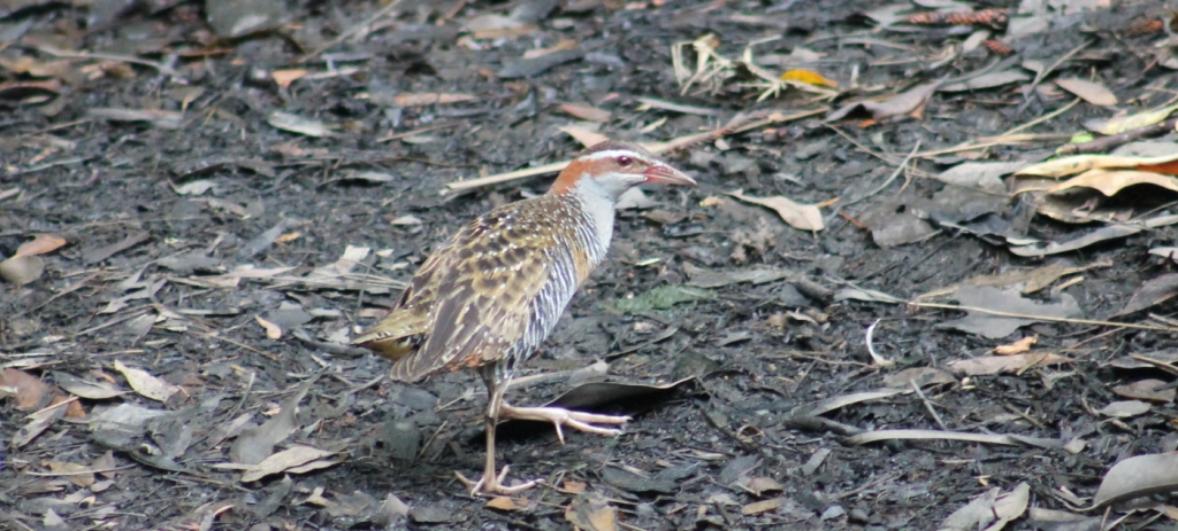
The mum.
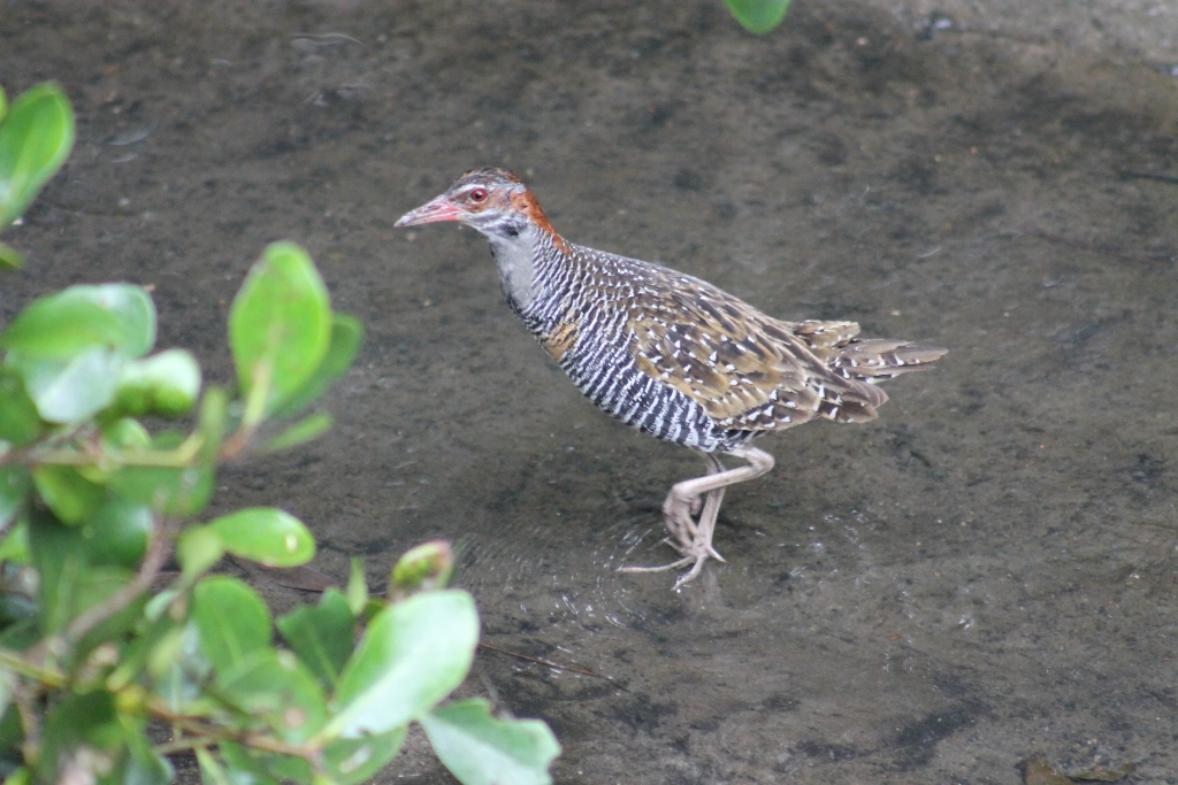
The dad. Photos: A J Guesdon
Banded Lapwing
Masked Lapwing (plover)
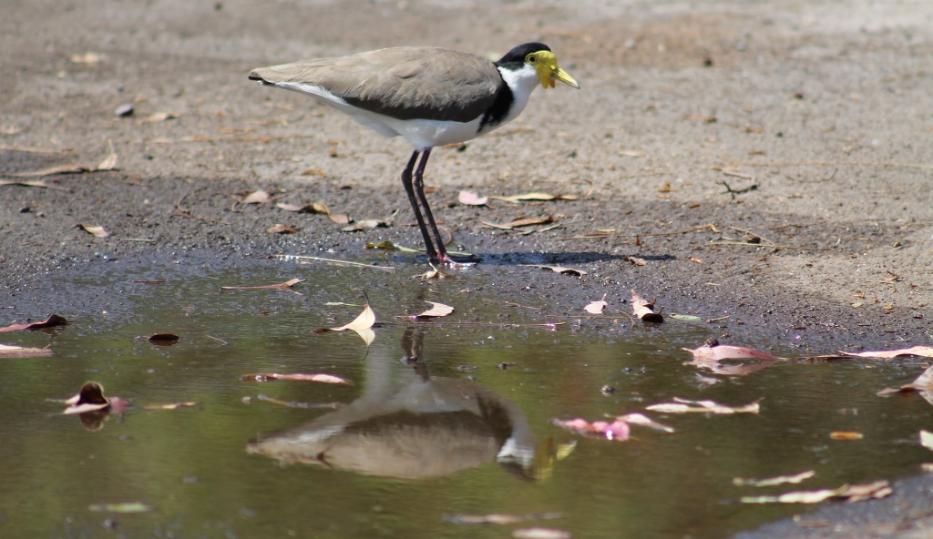
Masked Lapwing Plover - photo by A J Guesdon
The Masked Lapwing (Vanellus miles; name from the Latin for soldier and refers to the spurs, which give an armed appearance), previously known as the Masked Plover and often called the Spur-winged Plover or just Plover in its native range, is a large, common and conspicuous bird native to Australia. Its Aboriginal name: ‘baaldarradharra’.
This species is the largest representative of the family Charadriidae, at 35 cm (14 in) and 370 g (13 oz). The subspecies found in the southern and eastern states (Vanellus miles novaehollandiae), and often locally called the Spur-winged Plover, has a black neck-stripe and smaller wattles.
Masked Lapwings are most common around the edges of wetlands and in other moist, open environments, but are adaptable and can often be found in surprisingly arid areas. They can also be found on beaches and coastlines.
They make their nest in little hollows on the ground. The nesting pair defends their territory against all intruders by calling loudly, spreading their wings, and then swooping fast and low, and where necessary striking at interlopers with their feet and attacking animals on the ground with a conspicuous yellow spur on the carpal joint of the wing.
The bird may also use tactics such as fiercely protecting a non-existent nest, or a distraction display of hopping on a single leg, to attract a potential predator's attention to itself and away from its real nest or its chicks after they have commenced foraging. There seems to be some significant use of language to guide chicks during a perceived dangerous situation. Long calls seem to tell the chicks to come closer to the calling bird; a single chirp every few seconds to ask them to move away.
There is a much-believed but incorrect myth that the spur can inject venom. The myth may have been based on fear of the Masked Lapwing's territorial behaviour. Attacks are most vicious on other birds such as ravens, and also on cats and dogs, but once the chicks reach 60% of full size after 2–3 months, the chances of this happening decrease. Strikes are much rarer on humans since they are more aware. Sometimes the bird can damage its wing in a strike but usually survives and is flightless until the wing heals.
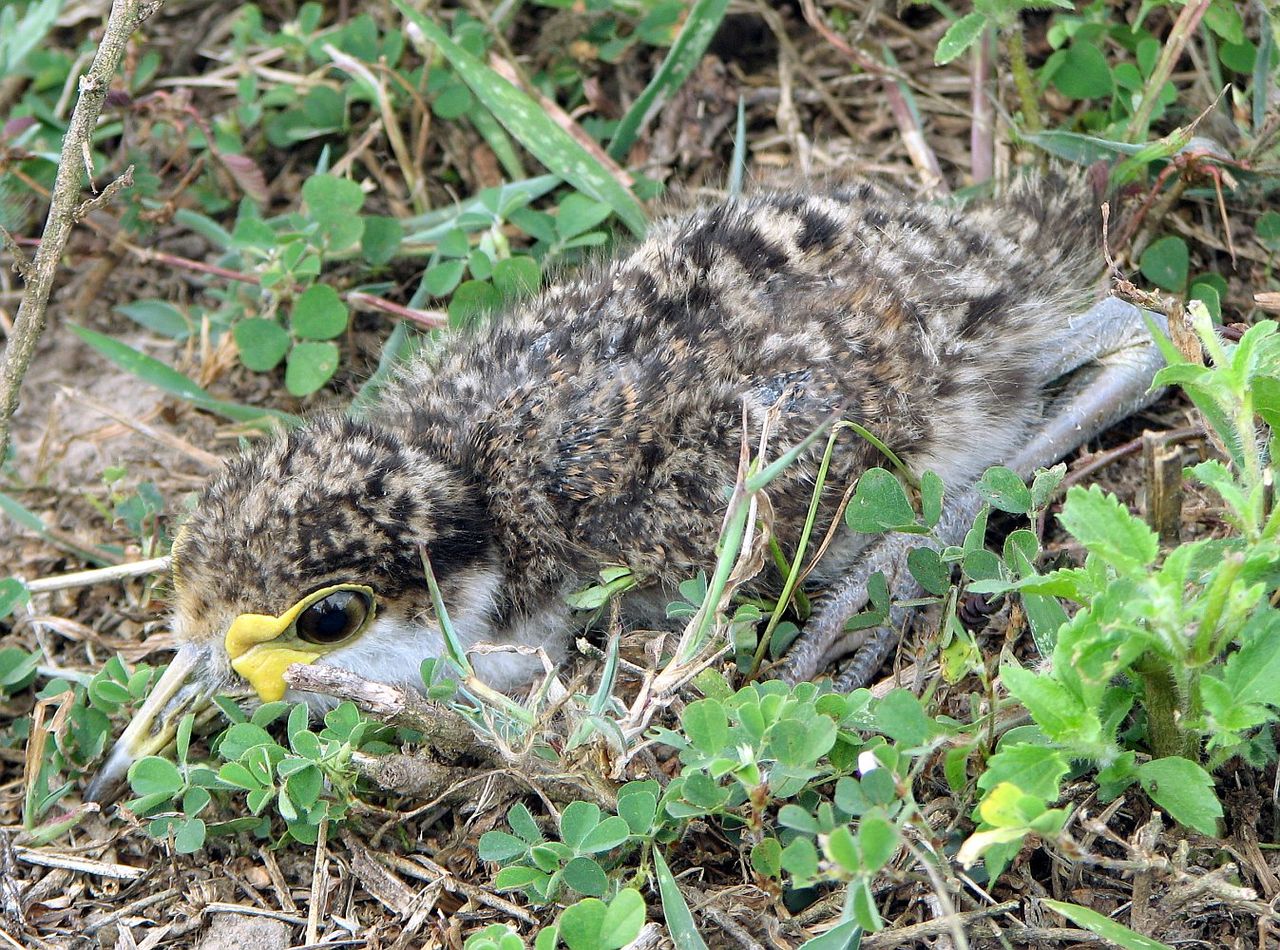
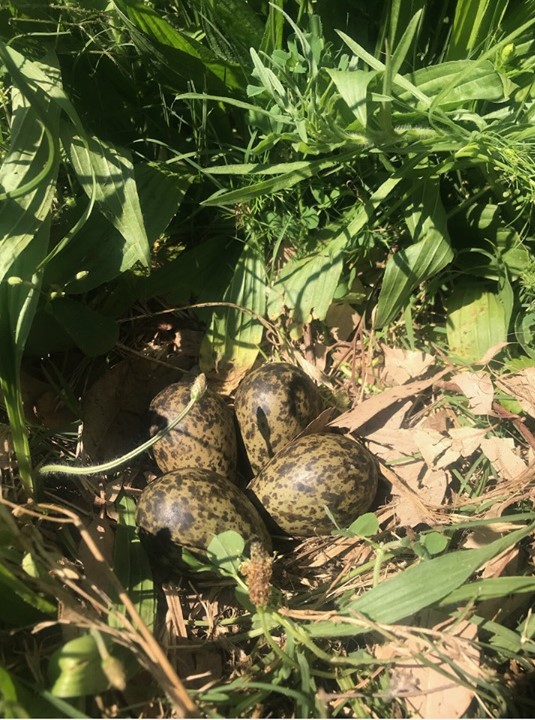
Young birds crouch and lie still when threatened - photo by Amos T Fairchild - A nest in m the grass at Mona Vale - photo by Margaret Woods
Painted Button-quail
The female builds a domed nest of leaves, sticks and grasses beneath a tussock of grass, or at the foot of a rock or sapling, and lays 3-4 eggs at a 2-3 day laying interval between each egg. The male incubates the eggs once the clutch is complete, and all the eggs hatch at the same time. The chicks leave the nest immediately and are only fed by the male for 7-10 days. The chicks can fly 10 days after leaving the nest. The painted buttonquail is about 19 to 20 cm (7.5 to 7.9 in) long. It is a ground-dwelling bird and is found in grassy forests and woodlands. It feeds on insects and seeds. Often the first sign that a Painted Button-quail is present in a dry, open forest is not a sighting of the bird, nor hearing its call, but a shallow depression of bare soil among the leaf litter. These bare patches, round and about 15 centimetres across, are called platelets or 'soup-plates'. Painted Button-quails forage for seeds and insects on the ground by spinning about on alternate legs to expose items of food among the leaves and on the soil surface, and it is this action that forms the platelets.
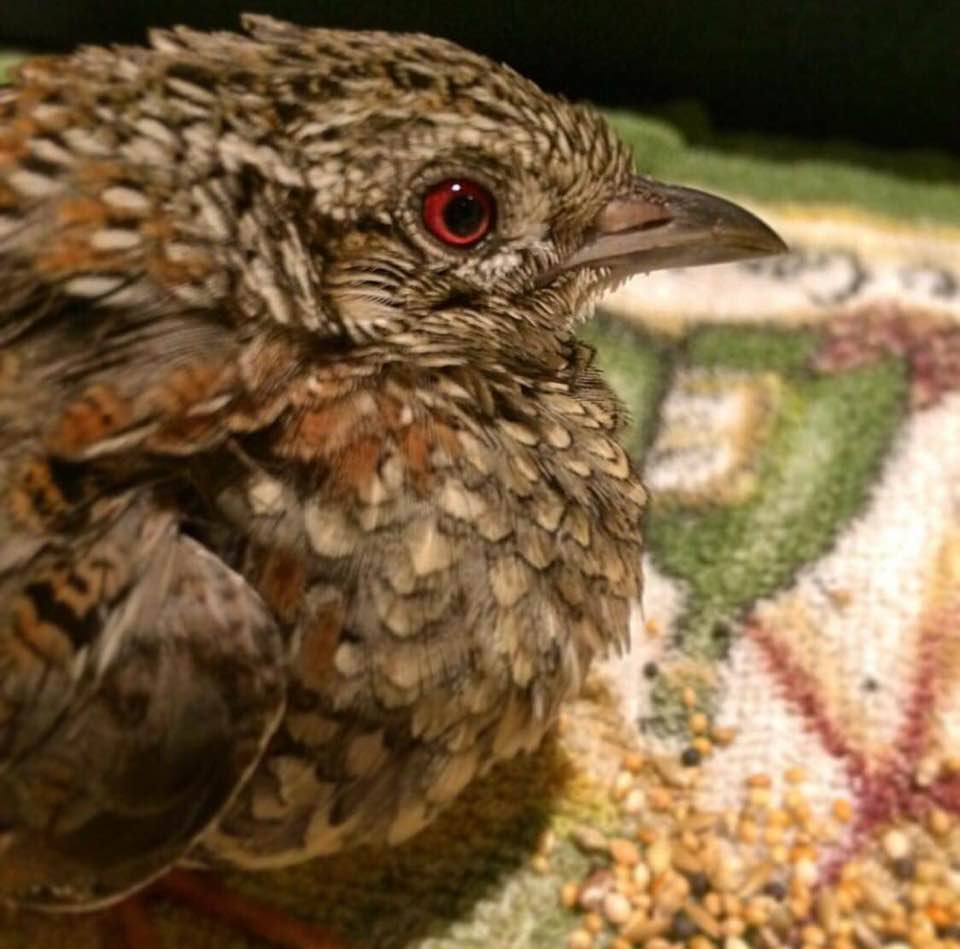
A Painted Button-quail rescued in Elanora Heights - photo by Lynleigh Greig
Painted Button Quail are active during the early evening from dusk on, at night and early morning, feeding on the ground. They are usually seen in pairs or small family parties, searching for seeds, fruit, leaves and insects.
Brush Turkeys
Brush- turkeys or Bush Turkeys (Alectura lathami) as they are sometimes called, belong to the megapodes family, meaning that they are incubator birds or mound-builders, and build large nests in which to incubate their eggs; the heat generated, like in compost bins, from these mounds of leaves is what incubates the eggs. The males build the nests.
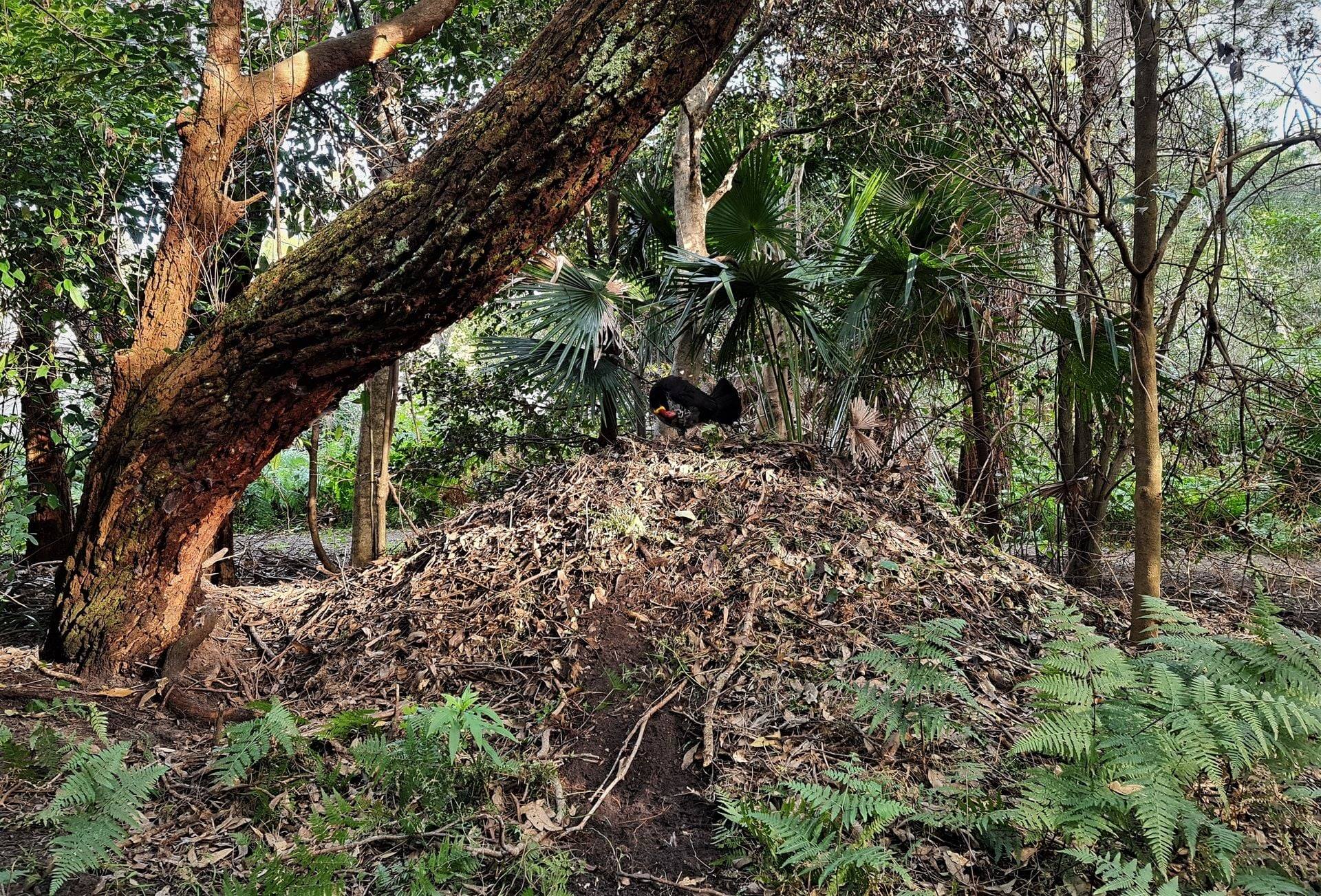
Brush/Bush Turkey nest at Irrawong Falls, Warriewood/Ingleside last week, July 7th, 2021 - photo by Joe Mills
Their name megapode literally means "large foot" (Greek: mega = large, poda = foot), and is a reference to the heavy legs and feet typical of these terrestrial birds. Several females will lay their eggs in the one mound (up to 30 eggs can be there although the average is 18-24) and the chicks are unusual among birds as they will hatch fully feathered and be able to fly within a few hours – a good thing as these birds are ground dwellers or not predisposed to flying for long times, although they can. They are able to run fast and jump over fences quite easily. Lyre birds are also ground dwellers.
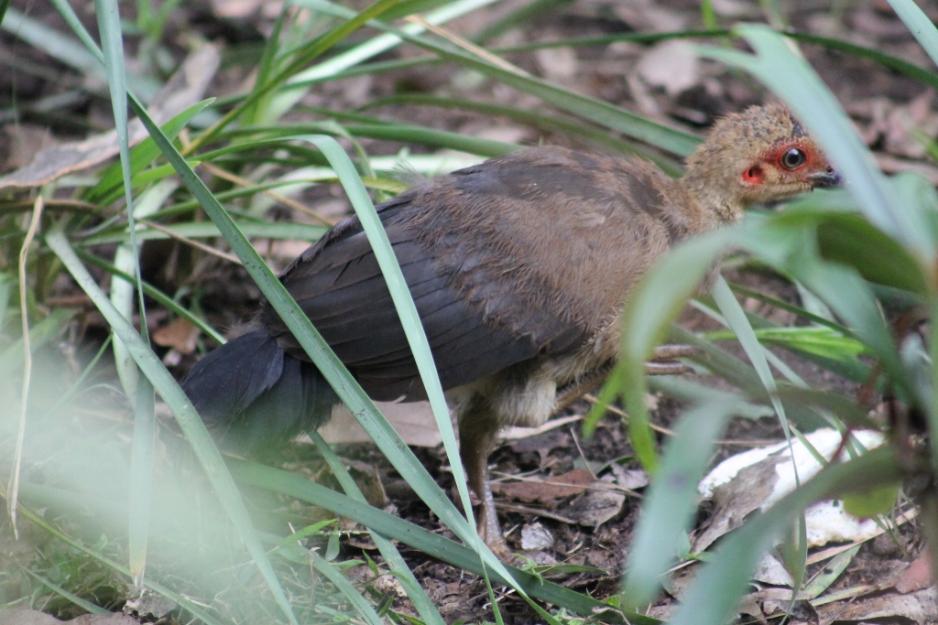
A young Brush-turkey that was scratching around in our backyard - this 'troop' seem to come through generation after generation via our 'patch';
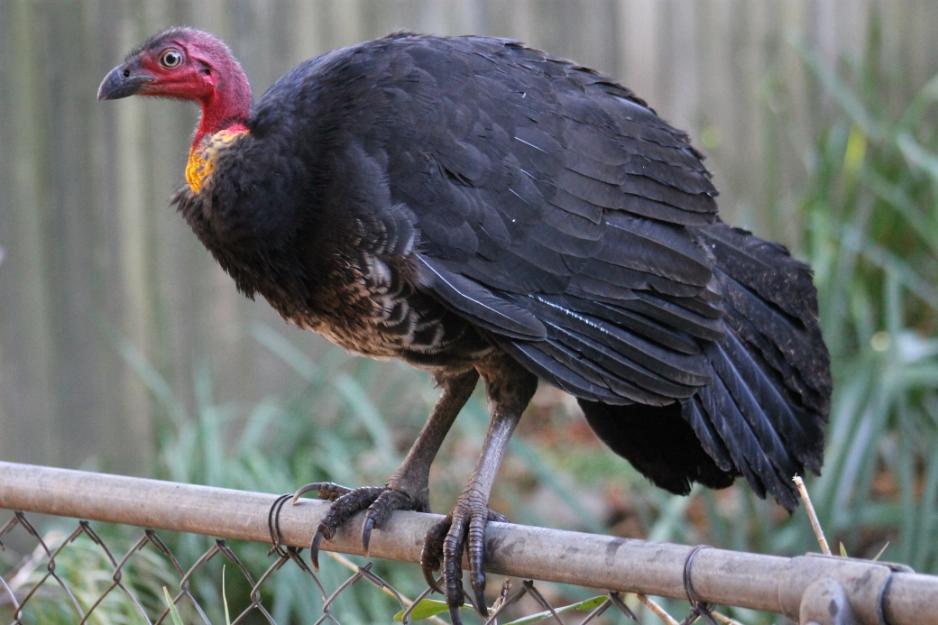
One of the parents pausing long enough to say 'good morning!'
Lyrebirds
There are 2 species in the family of lyrebirds - the superb lyrebird and the Albert's lyrebird. It is the superb lyrebird which gives the family its name. Its spectacular tail of fanned feathers, when spread out in display, looks like a lyre (a musical instrument of ancient Greece).
The male superb lyrebird is 80-100 centimetres long, including his 55-centimetre-long tail. He is dark brown on the upper part of his body and lighter brown below, with red-brown markings on his throat. His tail feathers are dark brown above and silver-grey below.
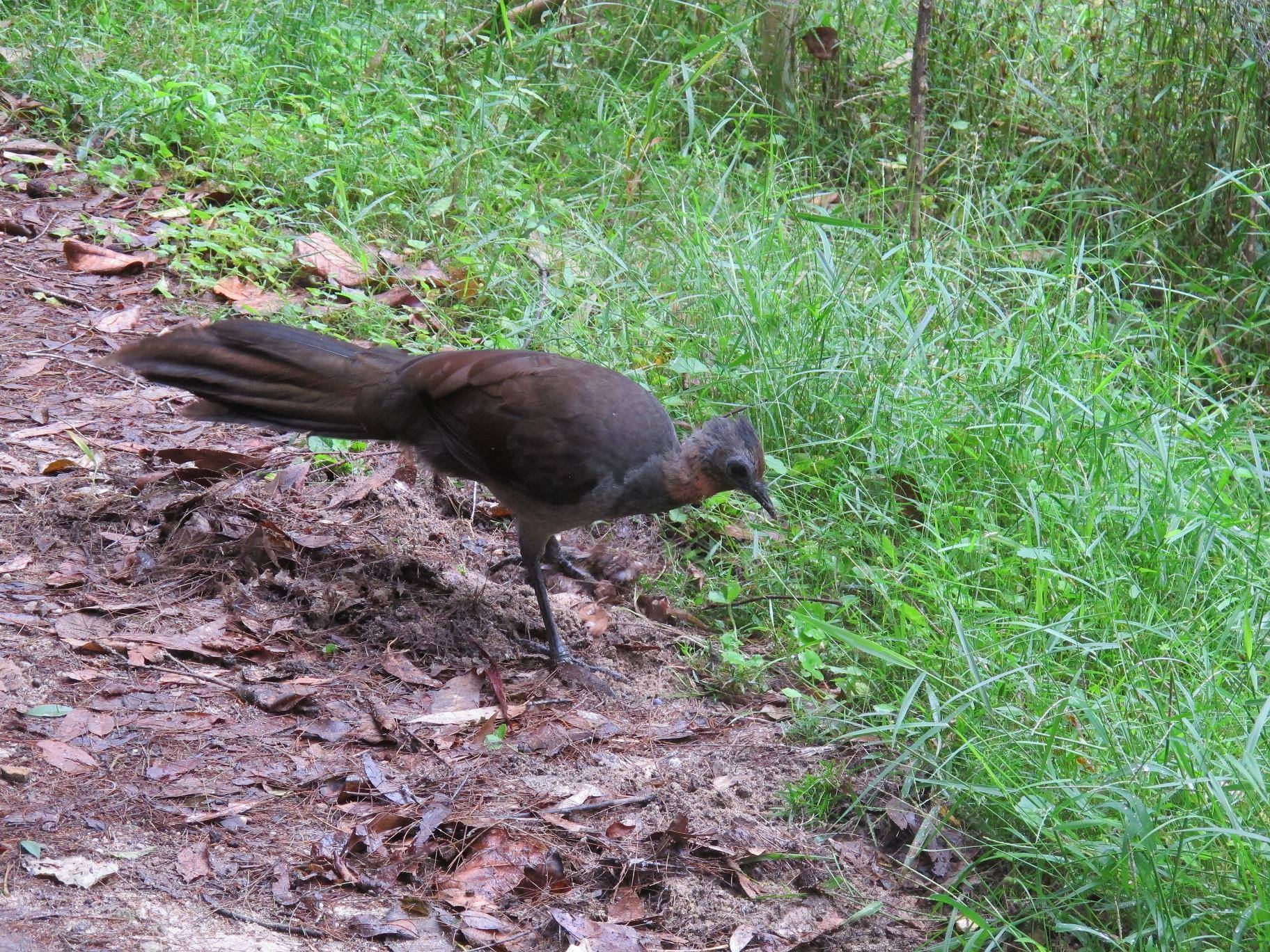
Lyrebird at Irrawong Falls, Warriewood - these are also seen/heard from West Pittwater to Whale/Palm Beach
Females of the species are smaller than the males, with similar colouring but without the lyre-shaped tail. The females' tail feathers are broadly webbed with reddish markings. Young male superb lyrebirds do not grow their lyre tails until they are three or four years old. Until this time, they usually group together and are known as 'plain-tails'.
The Albert's lyrebird is similar in appearance to the superb lyrebird, but is smaller and darker, with a rich chestnut colour. The male does not have the outer lyre-shaped tail feathers of the superb lyrebird. The Albert's lyrebird is listed as vulnerable in NSW.
The display period for both species is from May to August, with breeding occurring mainly in June and July. Females are attracted to the mound by the male's display and song. Male birds will mate with several females, and although they appear to know where the nests are, they take no part in building them or incubating and feeding the young.
The female builds a dome-shaped nest of sticks, which can be on the ground, on rocks, within tree stumps, or in tree ferns and caves. The nest is lined with ferns, feathers, moss and rootlets. Usually, only 1 egg is laid, which hatches in around 6 weeks. The young lyrebird remains in the nest for 6 to 10 weeks.
Lyrebirds are very shy birds. When threatened, they escape by running and dodging rapidly through the undergrowth emitting high-pitched shrieks of alarm. With their short, round, weakly-muscled wings they too are one of our ground-nesting birds that rarely fly. However, their wings allow them to jump onto tree branches or rocks - and then glide back down to the forest floor.
These nest on grasses, grass floats, sand, sand dunes, beach grasses alongside sand, and on ground on cliff platforms.
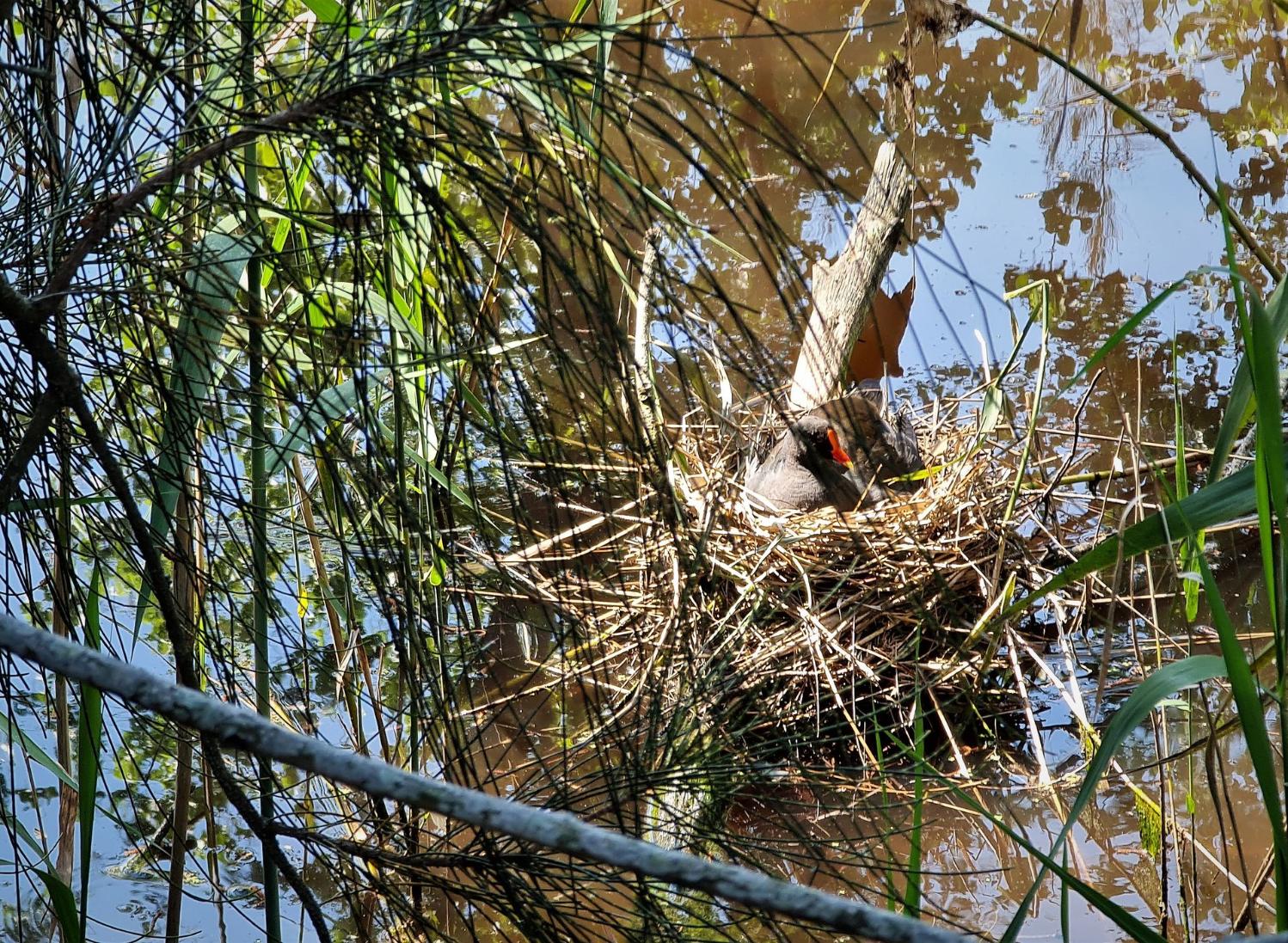
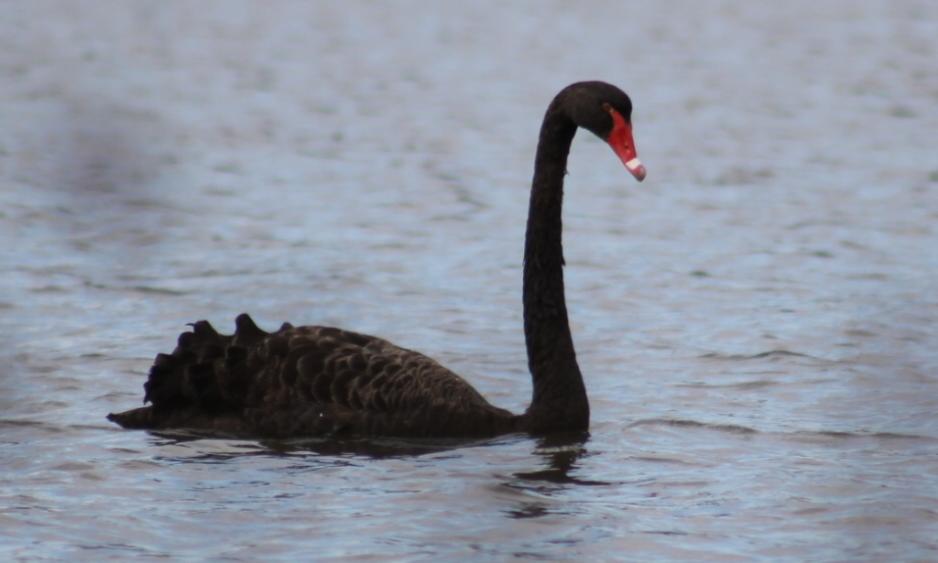
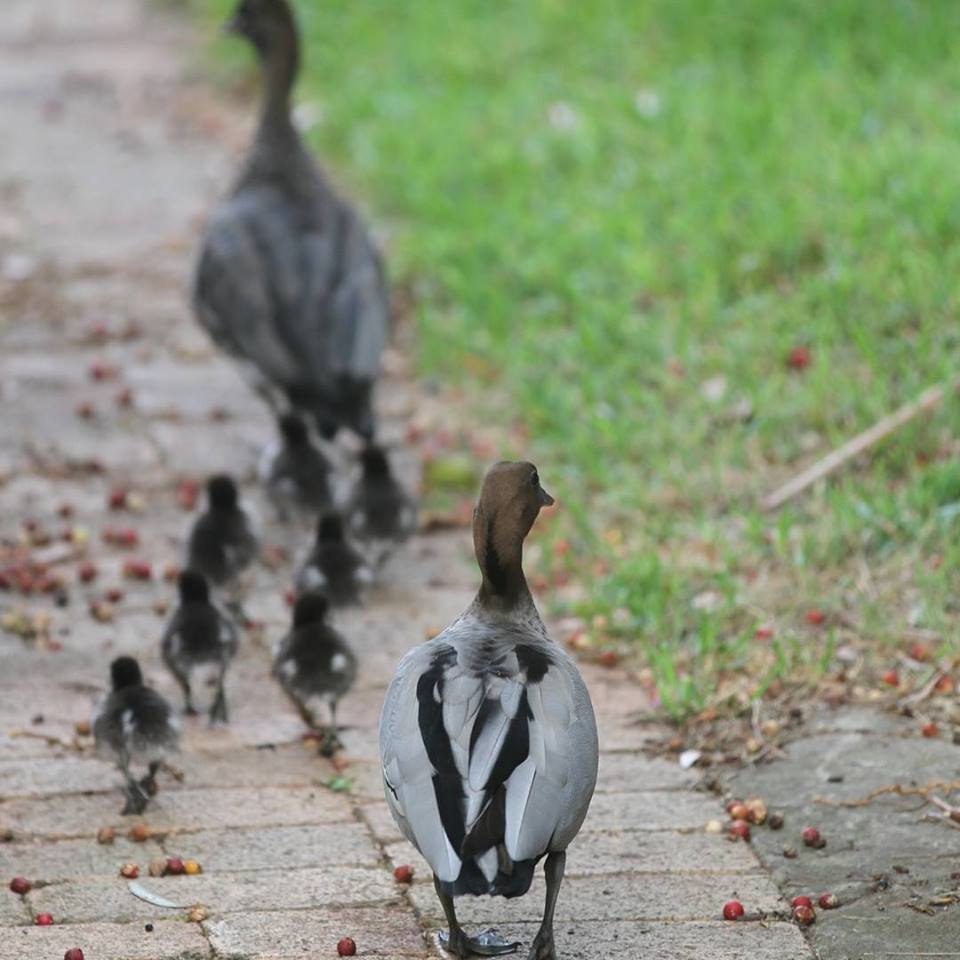
- Pied Oystercatcher
- Sooty Oystercatcher
- Beach Stone-curlew
- Red-capped Plover
- Hooded Plover
- Fairy Tern
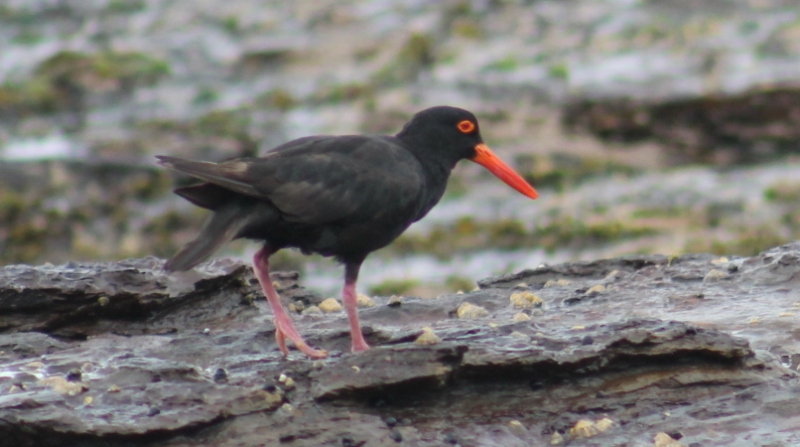
The Sooty Oystercatchers, Haematopus fuliginosus, a Seabird classified among Australia’s Shore birds and waders species, and are a black shorebird with a long red bill, red eye and pink legs. Young birds are duller and browner. It is often seen with the similar Pied Oystercatcher and they are Australia’s only all-black seabird and is found only found in coastal areas. The Sooty Oystercatcher is strictly coastal, usually within 50 m of the ocean. It prefers rocky shores, but will be seen on coral reefs or sandy beaches near mudflats.
- Stone Curlews
- Eastern Curlew, critically endangered
- Beach thick-knee
- Dotterels
- Pied Stilt
- Pied Oystercatcher
- Grey Plover
- Pacific golden Plover
- Lesser Sand Plover
- Greater Sand Plover
- Red-capped Plover
- Black-fronted Dotteral
- Whimbrel
- Far Eastern Curlew
- Bar-tailed Godwit
- Ruddy Tunstone
- Sharp-tailed sandpiper
- Red-necked Stint
- Sanderling
- Grey-tailed Tattler
- Wandering Tattler
- Pomarine Skau
- Pacific Gull
- Brown Noddy
- Black Noddy
- Sooty Tern
- Little Tern
- Caspian Tern
- White-fronted Tern
- Great Crested Tern
- Red-tailed Tropicbird
- Little Penguin (fairy penguin)
- Yellow- nosed Albatross
- White-capped Albatross
- Black-browed Albatross
- Flesh-footed Shearwater
- Wedge-tailed Shearwater
- Respect posted areas, even if you don't see birds inside them. Birds, eggs and nests are well-camouflaged among beach habitat, and disturbance by people can cause the abandonment of a nest.
- Give nesting birds a wide berth
- When fishing, be sure not to leave any equipment behind. Always dispose of fishing line and tackle appropriately.
- Avoid disturbing groups of birds. If birds take flight or appear agitated, you are too close.
- Refrain from walking dogs or allowing cats to roam freely on beaches. Even on a leash, dogs are perceived as predators by nesting birds, sometimes causing adults to abandon nests if disturbed, which leads to the loss of their chicks.
- Don't let pets off boats onto posted islands or beaches around Pittwater - especially the National Park.
- Do not bury or leave rubbish, picnic leftovers, charcoal or fish scraps on the beach. They attract predators of chicks and eggs.
- Beach-nesting birds sometimes nest outside of posted areas. If you notice birds circling noisily over your head, you may be near a nest. Leave quietly, and enjoy observing from a distance.
- Remember you are a visitor in their home and enjoy seeing them but conduct yourself as a good guest; be polite, don't make a mess, and while you don't have to thank them for having you over, perhaps give a thank you to the structures and people that protect these places for birds